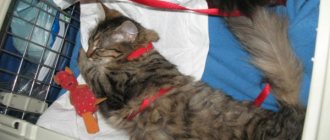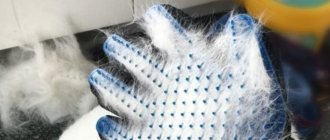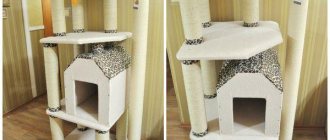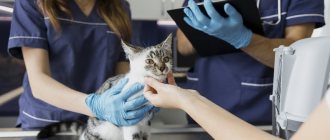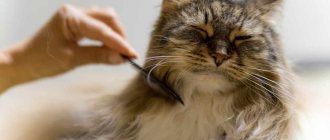Structure of a cat's ear
A cat's ears resemble human ears in structure and include:
- external, consisting of a funnel-shaped shell covered with wool with guard hairs inside and the auditory canal;
- in the middle there is an eardrum and a bone cavity with three bones, important in the perception of noise;
- internal - the most complex section, in which the vestibular apparatus and sound receptors are located.
In animals, the auditory canal, unlike the short human one, is curved and forms an angle. Improper cleaning can lead to wax buildup and blockage of the passage.
Cats can hear sound vibrations in the range of 20–100,000 Hz. Muscles and cartilage are able to rotate the shell to pinpoint the source of sound vibrations during hunting.
Drawing - diagram of the structure of a cat's ear
Cat ears. We clean our ears. Care.
Cleanliness and neatness of the ears is not only an integral attribute of the condition of an animal that claims to be worthy of a show, but also a mirror of health. Therefore, ear cleaning is included in the mandatory set of pet care procedures. Now we will put on the shelves various products designed to care for cat ears.
3 facts about the structure of the ear
Each ear (as an organ of hearing) is clearly divided into three parts: outer, middle and inner. The outer ear is the same pinna (a cartilaginous plate covered with skin on both sides). By nature's design, cartilage supports the ears in an erect position so that they can function as locators. Several groups of small muscles provide such expressive movements of the cat's ear. In the middle of the base of the auricle there is a small hole that passes into the external auditory canal; the latter is a curved cartilaginous tube lined with skin. There are special glands in the skin that secrete ear lubricant (earwax). The auditory canal abuts the eardrum, which serves as the border with the middle ear.
If the auricle and almost the entire ear canal border on soft tissue, then the following sections are protected by the bones of the skull. In the cavity of the middle ear there are three successively connected auditory ossicles (hammer, incus and stapes), which transmit vibrations of the eardrum to the membrane delimiting the inner ear. The bones are located at an angle (zigzag) and are equipped with two muscles, which makes it possible to regulate sound transmission. The inner ear consists of many closed tubes that contain fluid. The cochlea helps the cat hear: sound vibrations are transmitted to the fluid that fills the cochlea and washes the organ of Corti - a cluster of special sensitive hair cells that, through vibrations of the perilymph, perceive auditory stimuli in the range of 16,000 - 20,000 vibrations per second, convert them and transmit them to the nerve endings of the vestibule -cochlear nerve, through which the nerve impulse goes to the auditory center of the cerebral cortex. There are also semicircular canals in the inner ear, where nerve endings are located that record changes in the position of the fluid. Thanks to this, the cat is able to maintain balance and spatial orientation.
5 facts about dirt in ears
Earwax is not dirt. It serves to lubricate and naturally cleanse the ear canal. Sulfur consists of proteins, fats, free fatty acids, and mineral salts. Some proteins are immunoglobulins that perform a protective function. The pH of earwax is acidic, which counteracts the development of bacterial and fungal flora. Normally, earwax, along with the impurities accumulated on it (dead cells, sebum, dust and other impurities) are removed from the ear canal to the outside without human help. Nevertheless, sulfur is a sticky substance, and if it is produced a little more or there is hypersecretion of the sebaceous glands, then the ears will collect dirt many times faster. Even in the absence of inflammation, infection and parasites. Hairless cats - all kinds of sphinxes - are especially guilty of this. The amount of dirt in the environment, as well as the ability of a particular cat to penetrate the most contaminated places, also fatally affect the cleanliness of the ears. And the ability to self-wash differs among different individuals. No dependence on the number of cats in one apartment has been identified, although in some companies it is customary to lick each other’s ears. With proper nutrition and good maintenance, erect ears cause little trouble. They are usually cleaned before exhibitions or after outdoor adventures, on average once every two weeks. Unless, of course, the next inspection reveals excess sulfur and some other secretions. But Fold ears require a minimum of weekly inspection. Due to the hanging ear, air circulation is reduced, the temperature in the ear canal is increased, all this, if there are ear mites or bad microbes there, will create greenhouse conditions for them. But perhaps the most important thing is to remember that discharge may be a sign of an infectious disease. The use of hygiene products in such a case can locally improve the picture, but that’s all. And the disease will progress, and the patient’s condition as a whole will worsen. If your cat's ear is red and hot; there is a strong coating or crust on it, it is scratched; the cat shakes its head, often spins in place and constantly scratches behind the ear until it bleeds - consult your veterinarian!
6 release forms for ear care products
Pet Ear Cleansing Wipes To clean healthy ears, just gently wipe the accessible area of the ear with a tissue. Repeat if necessary. In other cases, wipes can be used up to three times a day or otherwise as prescribed by a veterinarian. You can take napkins with you anywhere, they are a convenient form. Powder. This form may not seem the most modern, but it works well thanks to an excellent antiseptic - iodoform, which is most effective in the form of powder and powder. Quickly relieves itching and irritation, controls bacterial growth. Helps painlessly remove unwanted hairs from the ear canal. Hygienic lotion (liquid) for cleansing ear secretions, softening the skin and removing odor. Some lotions add a powerful synthetic antiseptic. But there are also those made from herbal oils and extracts. You can moisten a cotton pad with it - if there is not a lot of dirt, this will be enough; in a more complex case, you can pour a few drops into the ear, lightly massage the base, and the lotion will come out along with the dirt. All that remains is to wipe the auricle with a dry cotton swab or disk.
Hygienic drops for ear care. Mild products may contain boric and salicylic acid plus plant extract (for example, eucalyptus). Recommended for routine ear care, as well as treatment before and after washing, swimming or walking outdoors. The technique of application is simple: holding the tip of your ear with two fingers, move it back, pressing it to your head. Insert the end of the pipette or bottle with cleaning liquid into the external auditory canal (shallowly, within sight). Drop the medicine into the opening of the ear canal, strictly following the instructions or doctor's prescription. Gently massage the outside of your ear. Therapeutic drops are acaricidal (in this case against ear mites) and complex, intended for the treatment of serious otitis media, which, as is known, can be caused by more than one pathogen (and mites may also be present). Therefore, the complex remedy includes an anesthetic, an antibiotic, an antiseptic, an acaricide, and even steroidal anti-inflammatory drugs. The drug is administered only into the dry ear canal, which has been previously cleaned with a cotton swab and lotion. Gel for ear care. It is also often a comprehensive remedy; for example, one of the popular gels contains extracts of 18 medicinal herbs, propolis, and chlorhexidine. Especially recommended for lop-eared friends. But gels are produced only on the basis of vegetable oils and extracts, without synthetic antiseptics.
3 main rules for cleaning ears
Not only the inner ear, but also the middle ear does not need our cleaning! Entrance there is closed to the animal owner; it is even impossible to penetrate into the cavity of the middle ear without breaking the eardrum. Fortunately, it is difficult to do this by conventional means, since the thin and long external auditory canal of a cat, unlike a human one, has a bend, which prevents our inexperienced hand from “sticking” improvised instruments into the membrane. But since there are no limits to human perseverance and cunning, we urge you: limit yourself to cleaning the auricle and the initial part of the external auditory canal.
A cat should be taught to clean its ears from infancy! Otherwise, “injuries at work” are inevitable. What if you don’t know how a new pet will react to manipulations or there is a need to examine and treat the ears of a cat that hasn’t needed your help for several years? Call for an assistant to restrain the animal, or use a special thick fabric bag to “pack” the client. The line between hygiene, preventative and veterinary products is now very thin. In modern products for regular routine care you can find not only an antiseptic, but also an antibiotic. I would like to hope that those products that should be used as prescribed by a doctor are sold in the pharmacy department, and not together with cosmetic and hygiene products. Uncontrolled use of antibiotics can lead to the selection of microflora resistant to them, and otitis media, after a short-term improvement, will become chronic...
It is not difficult to determine what species of animals this drug is intended for. The end consumer is not only written on the packaging, he is drawn there. Most of the products we've covered so far are intended for both dogs and cats. However, cats are more unpredictable in their reactions to drugs. It is in your interests to strictly follow the instructions and not experiment, since experiments increase the share of the unexpected. Not every company produces all of the described forms of care products. But three or four is enough. For example, cleansing wipes, powder, drops and lotion. After all, a cat owner may need both for a short period of time. Therefore, drugs from the same line have good compatibility and the instructions indicate how to use them. But it would be nice to get additional information about the compatibility of products from different companies.
Why do animals scratch their ears?
Scratching your pet's ears is a common hygiene procedure to remove dirt and particles. It is normal to itch several times a day.
What should alert the owner:
- When an animal constantly itches, shakes (shakes) its head vigorously, trying to free itself from an invisible object, and presses its ear with its paw.
- Anxiety, aggressiveness, irritability of the pet.
- Growling, hissing, meowing, and other sounds when scratching.
- Sores, sores, scratches behind the ears (near) and inside.
Such actions can be caused by domestic or pathological reasons.
Household problems are determined by the owner, go away on their own and do not require the intervention of a doctor. These are, in particular:
- water that got in while swimming;
- foreign object;
- minor hematoma from injury;
- scratches the neck - most likely fleas;
- accumulation of earwax due to insufficient care.
There may be cases when the pet lies down. So before you sound the alarm and take your cat to the vet, it’s better to make sure that there really is a problem.
Pathological causes are dangerous to health. The animal needs medical attention if the cause of scratching is:
- abscess;
- allergic reactions;
- fleas;
- fungal infections;
- benign or malignant neoplasms;
- otitis media of various origins;
- ear mites;
- eczema or dermatitis, going bald;
- swollen ear.
How to measure a cat's temperature
Health problems cannot always be determined visually, so it is recommended to regularly measure basic physiological indicators.
To measure the temperature , lubricate the tip of the thermometer with Vaseline or baby cream. Place the pet on its side, calm it down, lift its tail and insert the thermometer 1–2 cm into the anus.
To measure blood pressure, you can use a blood pressure monitor, which consists of miniature cuffs that are attached to the animal's hind limb and a highly sensitive Doppler sensor that detects the slightest appearance of blood flow. Pressure measurements should be taken several times, as there may be an error caused by the cat's nervousness during the procedure.
More accurate blood pressure readings can be obtained at a veterinary clinic using procedures such as oscillometric measurements and ultrasound devices.
To take the pulse, press your fingers against the cat's chest behind the elbows or in the hollow where the hind limb meets the body. Gently press on the indicated areas until you feel a pulse, then count the number of beats per minute using a watch with a second hand.
What diseases do ticks cause?
Ear scabies, also known as carnivore otodectosis, is a parasitic disease in which a mite lives in or on the pinna of the ear and infects the eardrum or ear canal. The blood-sucking insect causes itching, causing the cat to shake its head and meow. The ear may become scabby and fester. Without intervention, the disease causes complications: otitis, meningitis - or lead to the death of the animal.
Notoedrosis is caused by the sarcopid mite Notoedres cati. The ears, nose, and area under the eyes are affected. The tick affects the nervous, cardiovascular, and reticuloendothelial systems. First, the disease spreads to the muzzle and head, and then moves on to the rest of the body. The animal feels severe itching, scratches its ears, the skin dries out and becomes rough, and bleeding cracks and crusts form.
Otitis is an inflammation of the middle ear. The cat scratches its ears until wounds appear and shakes its head. At the same time, serous fluid with pus is released. This disease is caused by (where does it come from):
- ticks - as a complication of otodecosis;
- bacteria - with a weakened immune system or allergies, the yeast fungus Malassezia develops in the ears;
- both reasons at once - in this case mixed type otitis occurs.
Ear diseases
If, despite regular cleaning of the cat's ears, dirt accumulates in them more and more often, and also in cases where pus is found on a cotton pad or swab after the procedure, it is necessary to show the pet to a veterinarian. This may be a sign of some disease, which is always easier to cure at an early stage.
The most common diseases that affect a cat's ears include the following:
- Dermatitis (eczema). It is often caused by allergies. The fact that a cat has dermatitis can be recognized even by its appearance - the animal has red ears covered with a rash, hair begins to fall out from the affected part, which causes bald patches. The animal is constantly itching, which only makes the situation worse.
- Necrosis of the auricle. Formed when a hematoma becomes infected or as a result of prolonged compression, leading to poor circulation. The tissues gradually turn black and die. Only removal of the damaged part of the ear can help.
- Neoplasms and tumors. These include all kinds of papillomas, polyps, fibromas, etc. As they grow, they can lead to complete deafness. They are treated only surgically.
- Otitis. There are parasitic and bacterial. The first is caused by microscopic mites, which animals infect from each other. The cause of bacterial is a fungus or virus.
- Otodectosis is a disease caused by ear mites that parasitize mainly on the inner area of the ear. Often causes otitis media. A brownish coating mixed with blood can be found in the ear canal. The cat's ears are very itchy, which causes him great anxiety. The animal scratches the affected area with its paw, rubs its head on the furniture and any objects that get in its way.
Diagnosis is of great importance, so it is important to immediately contact a veterinarian if your pet notices discharge from the ear, an unpleasant odor, sores or redness of the ear, or squelching when pressing on the ear area. Hot ears and nose are not always a sign of illness, but in this case it does not hurt to measure the animal’s body temperature.
Systematic and proper ear cleaning will allow your cat to avoid many health problems.
How to determine when it’s time to clean your ears, what happens if you don’t?
Hygiene is one of the main components of caring for a pet. It is better to examine your pet every day: when playing or petting, you can carefully bend the ear and then look. The pet's health is fine if the sink is light pink, clean or with a small amount of sulfur, not dirty (no blackness).
Excess wax accumulates in the ear canal, attracting bacteria and parasites. The sulfur plug leads to irritation of the mucous membrane and begins to put pressure on the eardrum. This spoils hearing and disrupts vestibular functions: leads to impaired coordination of movements, nausea, and vomiting.
Accumulations of dirt can clog the glands, and the contents of the ears can be absorbed into the blood, leading to allergic otitis media. Without treatment, the inflammation spreads deeper and can lead to the death of the animal. With tick-borne otitis media, the parasite eats dead skin cells and causes itching. Scratched areas appear around the cat's ears, and dark spots of pus and sulfur appear inside.
If your pet shakes its head, itches or worries, and black plaque, redness, discharge or spots appear in the ears, this is a reason to contact a veterinarian at the veterinary clinic.
Photo - this is what an ear mite looks like
How does wax form in cats' ears?
Sulfur production is a natural process. Ear secretions produce earwax for several reasons:
- To lubricate and moisturize the skin in the auricle;
- To protect against bacteria entering the ears;
- To prevent the spread of fungi;
- To protect against the entry of foreign objects: dust, insects and other debris.
Basically, debris that enters the ear clumps in the wax and is eliminated from the body naturally. In healthy cats, sulfur has a paste-like consistency, is brown in color, and has no odor. If sulfur begins to acquire a pungent odor and changes color and consistency, this may indicate the onset of a disease.
When to clean your ears
Cleaning is divided into preventive and therapeutic.
For preventive purposes, cleaning is carried out every 2–4 weeks, depending on the breed, as well as the body of a particular animal. The large ears of Maine Coon, Savannah, Cornish Rex, Abyssinian, Oriental, Somali, Siamese cats, Devon Rex, elves, and Sphynx cats get dirty faster.
Sulfur is especially actively secreted in breeds without hair inside the hearing organ, since the hairs protect against pollution.
It is difficult to clean the ears of the Scottish Fold on your own, so it is recommended to clean them once every two weeks. A small amount of secretion protects your pet from disease, so there is no need to clean it more often.
Therapeutic cleaning of a Scottish or British cat is carried out before treatment against ticks, the use of antibiotics or antifungal drugs. Before each use of drops or rinses, the sink should be cleaned with saline solution or lotion. Parasites and bacteria produce their own byproducts that interfere with the action of medications. Cleaning is prescribed by a veterinarian and is carried out until complete recovery.
Healthy clean ears of a British cat
Symptoms of diseases
It is worth paying attention to the health of your pet if:
- redness of the skin;
- increased temperature in certain parts of the body;
- narrowing of the auditory canal;
- tumors;
- change in the color of sulfur;
- unpleasant strong odors;
- squelching sound when pressing;
- excessive sulfur secretion;
- accumulations of pus and fluid;
- various secretions with blood;
- decreased ability to perceive sounds;
- changes in behavior: the cat shakes its head or tilts it to one side, pulls its ear away or runs away when touched, often itches;
- black sulfur, streaks with impurities are a sign of a mite.
Black inclusions in sulfur are often ordinary dirt. If, after cleansing, minor inflammations remain on the skin, you should seek help from a specialist.
Colorless or milky discharge indicates a lack of microelements or vitamins.
Dry ears and waxy scales indicate dermatitis, as well as a lack of fat in the diet.
Allergies are indicated by colorless discharge from the nose, eyes, and ears.
The ears smell like fish if there is a staphylococcus infection, and rotten meat when there is suppuration.
Only a veterinarian can indicate the true cause of ill health and prescribe the correct treatment, so any of these symptoms require consultation.
Photo of bacterial otitis media
Tumor of the seruminous glands
Gene mutations in cats' ears
Of the well-known breeds, the Scottish Fold cats, whose ears are folded, and the American Curl, with their ears curved outward, have unique ears. It is noteworthy that kittens are born with straight, normal ears, which fold or bend within a few weeks.
Kittens are rarely born with other anomalies, for example, with four ears. In addition to the normal two, such cats have feathery growths that do not develop as the kitten grows up and do not have an ear canal. The placement and alignment of the accessory projections varies and may be posterior, anterior or lateral. In most cases, growths do not affect the cat’s health and can be removed.
In litters, cats can be born without an outer ear (pinna), while having a developed middle and inner ear, and not suffering from deafness. The absence of an auricle affects the ability to catch sounds, because the shell serves as a radar; by turning their ears, animals detect the source of sound.
As a result of the mutation, kittens can be born with curved ears, pressed to the head like Scottish fold cats, only turned in the opposite direction.
Preparing for cleaning: what to buy
To care for pets, only specialized preparations are used, especially when cleaning the ears. The products protect against fungus and bacteria, prevent infection, and are safe for pets. The instructions for the product should indicate cleaning, not instillation. Under no circumstances should you take anti-inflammatory drugs if there is no indication for it. For cleaning it is recommended to use:
- AUROCLEAN with chamomile extract softens sulfur;
- Leopard, Dewdrop for cleansing ears;
- EAR cleaner cleans;
- Euracon Pharma Otoklin removes dead skin cells, softens sulfur, moisturizes;
- Doctor Vic softens sulfur, used before using medications;
- Veda acts as an antiseptic, heals, removes inflammation;
- Vetoquinol Otifri eliminates impurities, relieves itching, and improves the condition of microflora.
Instead of lotion, you can use saline solution, boiled water, or chamomile decoction.
What does the position of the ears indicate?
A cat uses its ears as a way to communicate with other cats. You can judge the animal's mood by the position of its ears. So, for example, if the cat is relaxed, then the ears are directed forward and slightly tilted to the side. In an alert state, they are directed upward and forward; in case of danger, experiencing fear, the pet presses its ears back, they can twitch nervously.
What is not allowed during processing is prohibited
The ears of adults and kittens are sensitive and need careful attention. Doctors do not recommend when cleaning:
- use soap, iodine, vinegar, alcohol lotions, hydrogen peroxide. These drugs can cause irritation and dryness;
- use cotton swabs, wrap cotton wool around matches. This can damage the eardrum or push debris into the ear canal instead of out.
Lumps or discharge in the ears are a signal to consult with veterinarians at veterinary clinics.
What you need to prepare for cleaning
Before cleaning your cat's ears, you need to purchase everything you need for this from the pet store in advance.
Homemade devices in the form of cotton wool wound onto sticks or matches are not suitable for this purpose. A cat's hearing aid is too delicate, so it is very easy to damage it, scratch it and cause infection.
Everything must be done with the utmost care, using special accessories, so that you do not have to undergo long-term treatment later.
It is necessary to stock up on ear sticks with limiters or cotton pads, as well as gel intended for such procedures. It contains disinfecting and caring components, which greatly facilitates all care. It is not recommended to use hydrogen peroxide or other means, as this leads to drying of the surface of the ear, the formation of wounds, which, in turn, stimulates the production of wax, and the ears become even more dirty.
Cleaning the ears of adult cats
Before the procedure, your pet should be calmed down. Screenings will not cause concern if done from a young age. To prevent the animal from harming itself and its owner when cleaning, the cat can be restrained by wrapping it in a soft towel, leaving its head outside.
Cleaning (washing) the ears of animals is not painful, but it is unpleasant. Wiping the inside of the ears of cats and dogs is not enough. Contaminants should be removed from the ear canal without damaging the organ. How to clean it properly:
- Place your pet on your lap or other comfortable surface.
- Apply the cleansing agent until the canal is filled.
- Press the edge of your ear to the ear canal and massage in a circular motion. The liquid inside should be audible.
- Make the cat shake its head. This will remove contaminants out.
- Wrap your finger in a paper towel (can be replaced with a napkin or gauze), remove any remaining dirt. There is still dirt left, repeat steps 2-4, move to the other ear.
- At the end of the procedure, give your pet a treat.
If there is too much contamination, a home procedure may not be enough. If an unpleasant odor appears, contact a specialist who will use professional cleaning products and also prescribe the necessary treatment, if necessary.
Ear Examination Flashlight
How to clean it step by step
- Relaxed state. Cleaning is easy to do while the cat is sleepy and calm.
- Blocking movements. To prevent the owner from injuring the cat, and also to prevent the cat from injuring the owner, it is necessary to fix the cat’s position in a soft blanket, sheet or towel.
- Extremely careful turning the ears outward and inspecting them for dirt using a flashlight.
- If there is an abundance of plaque, the ears are treated with appropriate drops and lotions.
- Cleaning is carried out using the “inside-out” method, removing all the dirt in the ear canals. Dirty cotton pads or sterile bandages are replaced with clean ones until the canals are completely clean.
- Using cotton swabs dipped in lotion, the outer folds and skin are thoroughly processed.
- Once cleaning is completed, the pet is released and given a treat as a reward. This helps to introduce your pet to ear cleaning in the future.
For detailed instructions on cleaning cats' ears, watch the video on cleaning a cat's ears.
How to clean a kitten's ears
Kittens' ears require inspection and cleaning no less than those of adults. At the same time, the kitten behaves unpredictably and experiences stress.
How to care? The baby must be restrained before the procedure to avoid injury (usually, the kitten is not allowed to have its ears cleaned). An active kitten can be swaddled so that only the head is exposed. Do not tighten your pet's paws to avoid further scaring. After the procedure, give the kitten a treat to compensate for the stress caused. If you clean your kitten regularly, it will get used to it and become calmer. To clean, you will need cotton pads and cleansing lotion or boiled water.
- Gently open the ear with your thumb and forefinger.
- Wet the disc with cleaning fluid.
- Wipe the ear from the inside to the exit.
How a cat's ears are responsible for balance
In the inner ear, the three semicircular canals are oriented at right angles to each other. When you turn your head, the fluid in the channels moves, letting the brain know the direction of the turn and tilt of the head. Another part of the inner ear responds to gravity by sending information to the brain about the stationary position of the head. The principle of the inner ear is somewhat reminiscent of a tool called an “artificial horizon”, thanks to which the pilot aligns the position of the wings in relation to the horizon. Even when jumping or falling from a height, thanks to the inner ear, a reflex is triggered, giving the cat a signal to take a position that allows it to land on all four paws. It is believed that tailless breeds have a more sensitive vestibular apparatus, which compensates for the lack of a tail, which is also responsible for balance and balance.




